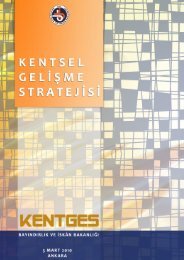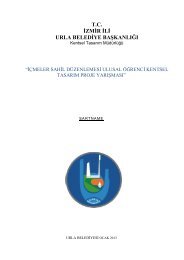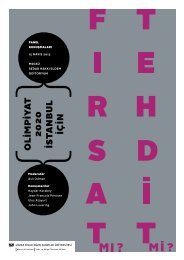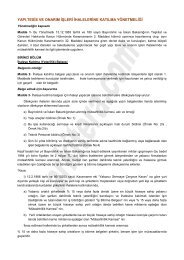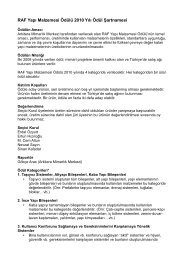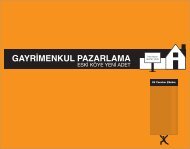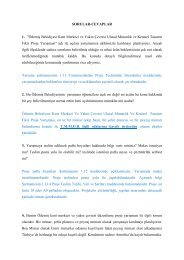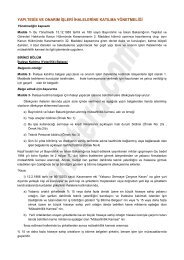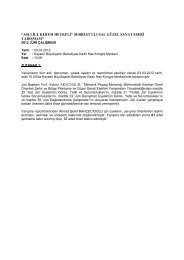VitrA ÃaÄdaÅ Mimarlık Dizisi - Arkitera
VitrA ÃaÄdaÅ Mimarlık Dizisi - Arkitera
VitrA ÃaÄdaÅ Mimarlık Dizisi - Arkitera
You also want an ePaper? Increase the reach of your titles
YUMPU automatically turns print PDFs into web optimized ePapers that Google loves.
The facility was constructed on one of the numerous adjacent tourism parcels situated<br />
perpendicular to the sea at Lara, Antalya. Rather than the conventional architectural<br />
approach of the region that consists of a fragmented polyphonic mass organization,<br />
a simple and solid mass was chosen, in which the buildings are situated towards<br />
the west of the site and the eastern and southern (seaside) spaces are used as open<br />
recreation spaces. This different mass scheme has led to an unexpected contrast<br />
with the neighboring facilities. The main bedroom mass was constructed using the<br />
maximum height and front façade width limits allowed by the regulations and orienting<br />
all rooms towards the sea. The huge void between the two bedroom masses is covered<br />
by a semi-transparent shelter and has thus been added to the indoor social spaces of<br />
the hotel.<br />
✎<br />
Antalya Airport opened in 1960 and triggered the development of Antalya in the eastern<br />
direction. As a consequence of the addition of the first international terminal in<br />
1998, the addition of the second international terminal in 2005 and the declaration of<br />
the Lara-Kundu coastline as the “Antalya Kemerağzı-Kundu Culture and Tourism Conservation<br />
and Development Zone” in 2004, the dunes and the agricultural areas located<br />
at the coast rapidly filled with tourism investments. A series of adjacently positioned<br />
luxury hotel complexes stretches along the road passing 500-750 meters inside the<br />
coastline, and has transformed the region. The opening of WOW Topkapı Palace, the<br />
first thematic hotel in Turkey in Kundu in 1999 determined the architectural character<br />
of the region while instigating the trend of thematicity, which, in time has come to<br />
dominate tourism investments.<br />
Due to its mass nature, the tourism industry has rapidly consumed the area and its<br />
identity. This development of the tourism industry has a homogenizing effect that systematically<br />
destroys the regional characteristics to be replaced by characteristics that<br />
“seem to be regional”. The new identity promises a fictional authenticity and simulated<br />
cultural animations, and the past years have seen an increase in the number of touristic<br />
spaces with this sort of fictional reality. However, these phantasmagoric atmospheres<br />
that present satisfactory experiences for masses of tourists focused on the<br />
consumption of ready-made images, packaged scenarios and staged views, partially<br />
lost their appeal after the 2000s. These atmospheres have been rejected by the new<br />
“post-tourist” consumers who are aware of the deceptive nature of tourism complexes<br />
that promise fake authenticity and fictional realities. The new non-thematic new type<br />
of tourism buildings focus on comfort, recreation and pleasure demanded by this “posttourist”<br />
group.<br />
With its non-thematic architectural approach, Lara Kervansaray Hotel and Congress<br />
Center is shaped by the demands of post-tourist consumers, and has a distinguished<br />
location within the surreal atmosphere of the Lara coastline. The disadvantages of its<br />
780 meter long but relatively narrow site have been transformed into a strong architectural<br />
statement through a focus on the concept of linearity. The complex has played<br />
a leading role in efforts to create a new ethical code based on architectural statement<br />
rather than themes in tourism architecture.<br />
58



